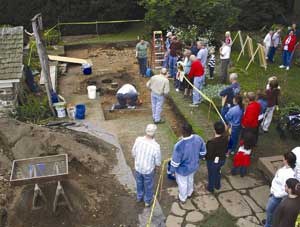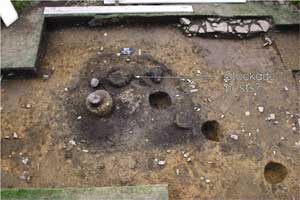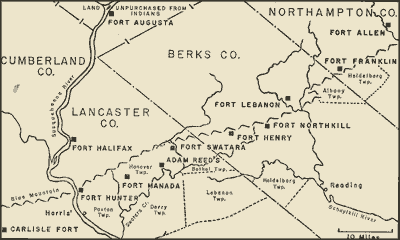Fort Hunter Archaeology
Come Visit Us
Every fall since 2006 the Archaeology Section has led an excavation at Fort Hunter Mansion and Park in Harrisburg, PA. On September 2nd the search for the fort at Fort Hunter Mansion and Park will resume. Excavations have documented the historic and prehistoric occupations at the site. While previous years have not been successful in locating the stockade or other fort structures, a new year brings new opportunities, and archaeologists will be on hand Monday-Friday, 9am-4pm to answer questions about the site and offer brief descriptions of the archaeological process. In addition to weekdays, excavation will take place on Fort Hunter Day, to be held Sunday, September 20, 2015. Excavations will close on October 2, 2015.
The goal is to locate the remains of the French and Indian War era supply fort occupied between 1757 and 1763. This will mark the tenth season of this project and numerous fort period artifacts and features have been recovered - some of these may be part of the fort occupation. The stockade and the blockhouse, however, have yet to be located as our excavations continue.

Goals for the 2015 Investigations
The 2015 archaeological investigations will be conducted primarily in the back yard, in the area around the icehouse. A hole in the rear wall of the icehouse measuring approximately two feet in diameter was uncovered in 2013. The area produced artifacts from the late 19th century and spurred additional testing in 2014. A poorly defined linear stain in the area of the hole revealed a box with rough cut wooden sides with several long spikes protruding vertically from the sides. The spikes suggest that wood was attached to the top. It appears to have been a rectangular box extending from near the icehouse wall, north, possibly funneling water over the cliff that drops 36 feet to Fishing Creek. We plan on completing excavation of this feature and will hopefully be able to determine its function. Auguring in the ice house is planned for 2015 as well in the hopes of confirming references in the historic record to its depth of either 15 or 20 feet deep.
Plans include further investigation of a circular rock foundation, 12 feet in diameter, located east of the icehouse that was discovered in the last week of excavations in 2014. Many of the rocks are large cobbles, but there is also a mixture of smaller cobbles and dressed pieces of diabase. There is a significant builder's trench about 18 inches deep associated with this feature. The rocks do not appear to be aligned for a foundation but seem to have been disturbed. Possibly, the foundation was partially removed (robbed) to be used in some other structure. There also seems to be a small open ended rectangular structure on its north side. More excavation is required in and around the rectangular attachment and the features in the center of the rock circle. Few artifacts were recovered from these features, but most date to the 18th century. These include scratch blue stoneware, a gunflint, musket ball and the near complete lock from a Brown Bess musket. Along with these early artifacts, the low density of artifacts also suggests that these are early features.

About Fort Hunter
Fort Hunter was designed as a supply fort. However, there are no verifiable accounts that anything more than a blockhouse was actually ever built, and the exact location of a stockaded fort has long been debated. There is a reference that the logs for the stockade had been cut, but there are no accounts of the posts ever being erected. The site is currently being interpreted as a 19th- to 20th-century manor and farm. Archaeological investigations conducted west of the mansion in the 1960s were negative.
Thanks to a grant from the Pennsylvania Historical and Museum Commission, Fort Hunter Mansion first contracted with Enviroscan, Inc. of Lancaster to conduct a remote sensing survey of the area where the fort supposedly existed. Enviroscan conducted a magnetic and ground penetrating radar survey that located subsurface remains or "anomalies" that may have represented evidence of the fort. However, these required an archaeological excavation to determine their exact nature. CAP archaeologists, assisted by a loyal group of volunteers and students, began investigations to verify or "ground truth" these remains in early September and worked for five weeks. The site was open to the public, and thousands of visitors viewed the excavation and interacted with the archaeologists.
Initially, none of the anomalies test by CAP turned out to represent fort features. The field strategy was revised, and historic documents were used to re-prioritize the excavations. There are several references to the "commanding view of the Susquehanna River" from the fort. The current garden area, located northeast of the mansion, certainly fits this description. When this area was tested, amazingly, thousands of artifacts from the 1700s were recovered. These included nails, gunflints, in both English and French flint, pottery such as delft ware, scratch blue stone ware, locally-made redware, and military buttons. Remains of posts and other subsurface features that probably represent parts of the fort were also found. Unfortunately, the excavation was only about 30 feet by 20 feet, and CAP was not able to exactly determine the bounds of the fort.
